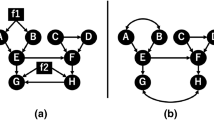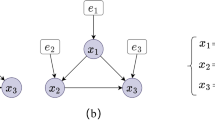Abstract
We consider the problem of estimating directed acyclic graphs from observational data. Many studies on functional causal models assume the independence of noise terms. Thus, they suffer from the typical violation of model assumption: heteroscedasticity. Several recent studies have assumed heteroscedastic noise instead of additive noise in data generation, though most of the estimation algorithms are for bivariate data. This study aims to improve the capability of continuous optimization-based methods so that they can handle heteroscedastic noise under multivariate non-linear data with no latent confounders. Numerical experiments on synthetic data and fMRI simulation data show that our estimation algorithm improves the estimation of the causal structure under heteroscedastic noise. We also applied our estimation algorithm to real-world data collected from a ceramic substrate manufacturing process, and the results prove the possibility of using the estimated causal graph to accelerate quality improvement.
Access this chapter
Tax calculation will be finalised at checkout
Purchases are for personal use only
Similar content being viewed by others
References
Bollerslev, T., Engle, R.F., Nelson, D.B.: Arch models. Handb. Econometrics 4, 2959–3038 (1994)
Byrd, R.H., Lu, P., Nocedal, J., Zhu, C.: A limited memory algorithm for bound constrained optimization. SIAM J. Sci. Comput. 16(5), 1190–1208 (1995)
Cai, R., Chen, W., Qiao, J., Hao, Z.: On the role of entropy-based loss for learning causal structures with continuous optimization. arXiv preprint arXiv:2106.02835 (2021)
Cai, R., Ye, J., Qiao, J., Fu, H., Hao, Z.: FOM: fourth-order moment based causal direction identification on the heteroscedastic data. Neural Netw. 124, 193–201 (2020)
Colombo, D., Maathuis, M.H., et al.: Order-independent constraint-based causal structure learning. J. Mach. Learn. Res. 15(1), 3741–3782 (2014)
Davidson, R., MacKinnon, J.G.: Econometric Theory and Methods, vol. 5. Oxford University Press, New York (2004)
Glymour, C., Zhang, K., Spirtes, P.: Review of causal discovery methods based on graphical models. Front. Genet. 10, 524 (2019)
Harvey, A.C.: Estimating regression models with multiplicative heteroscedasticity. Econometrica: J. Econometric Soc. 461–465 (1976)
Hoyer, P., Janzing, D., Mooij, J.M., Peters, J., Schölkopf, B.: Nonlinear causal discovery with additive noise models. Adv. Neural Inf. Process. Syst. 21, 689–696 (2008)
Hyvärinen, A., Karhunen, J., Oja, E.: Independent Component Analysis. Wiley, New York (2001)
Hyvärinen, A., Oja, E.: Independent component analysis by general nonlinear Hebbian-like learning rules. Sig. Process. 64(3), 301–313 (1998)
Khemakhem, I., Monti, R., Leech, R., Hyvärinen, A.: Causal autoregressive flows. In: International Conference on Artificial Intelligence and Statistics, pp. 3520–3528. PMLR (2021)
Kupek, E.: Detection of unknown confounders by Bayesian confirmatory factor analysis. Adv. Stud. Med. Sci. 1(3), 143–56 (2013)
Londei, A., D’Ausilio, A., Basso, D., Belardinelli, M.O.: A new method for detecting causality in fMRI data of cognitive processing. Cogn. Process. 7(1), 42–52 (2006)
Ma, S., Tourani, R.: Predictive and causal implications of using Shapley value for model interpretation. In: Proceedings of the 2020 KDD Workshop on Causal Discovery, pp. 23–38. PMLR (2020)
Makhlouf, K., Zhioua, S., Palamidessi, C.: Survey on causal-based machine learning fairness notions. arXiv preprint arXiv:2010.09553 (2020)
Moneta, A., Entner, D., Hoyer, P.O., Coad, A.: Causal inference by independent component analysis: theory and applications. Oxford Bull. Econ. Stat. 75(5), 705–730 (2013)
Pearl, J.: Causality. Cambridge University Press, Cambridge (2009)
Peters, J., Bühlmann, P.: Identifiability of Gaussian structural equation models with equal error variances. Biometrika 101(1), 219–228 (2014)
Peters, J., Mooij, J.M., Janzing, D., Sch"olkopf, B.: Causal discovery with continuous additive noise models. J. Mach. Learn. Res. 15, 2009–2053 (2014)
Reisach, A.G., Seiler, C., Weichwald, S.: Beware of the simulated DAG! Varsortability in additive noise models. arXiv preprint arXiv:2102.13647 (2021)
Rojas-Carulla, M., Schölkopf, B., Turner, R., Peters, J.: Invariant models for causal transfer learning. J. Mach. Learn. Res. 19(1), 1309–1342 (2018)
Shimizu, S., Hoyer, P.O., Hyvärinen, A., Kerminen, A., Jordan, M.: A linear non-gaussian acyclic model for causal discovery. J. Mach. Learn. Res. 7(10) (2006)
Shimizu, S., et al.: DirectLiNGAM: a direct method for learning a linear non-gaussian structural equation model. J. Mach. Learn. Res. 12, 1225–1248 (2011)
Smith, S.M., et al.: Network modelling methods for FMRI. Neuroimage 54(2), 875–891 (2011)
Spirtes, P., Glymour, C., Scheines, R., Kauffman, S., Aimale, V., Wimberly, F.: Constructing Bayesian network models of gene expression networks from microarray data (2000)
Spirtes, P., Glymour, C.N., Scheines, R., Heckerman, D.: Causation, Prediction, and Search. MIT Press, Cambridge (2000)
Strobl, E.V., Lasko, T.A.: Identifying patient-specific root causes with the heteroscedastic noise model. arXiv preprint arXiv:2205.13085 (2022)
Vuković, M., Thalmann, S.: Causal discovery in manufacturing: a structured literature review. J. Manuf. Mater. Process. 6(1), 10 (2022)
Xu, S., Mian, O.A., Marx, A., Vreeken, J.: Inferring cause and effect in the presence of heteroscedastic noise. In: International Conference on Machine Learning, pp. 24615–24630. PMLR (2022)
Zheng, X., Aragam, B., Ravikumar, P., Xing, E.P.: DAGs with NO TEARS: continuous optimization for structure learning. In: Proceedings of the 32nd International Conference on Neural Information Processing Systems, pp. 9492–9503 (2018)
Zheng, X., Dan, C., Aragam, B., Ravikumar, P., Xing, E.: Learning sparse nonparametric DAGs. In: International Conference on Artificial Intelligence and Statistics, pp. 3414–3425. PMLR (2020)
Zhou, S.: Thresholding procedures for high dimensional variable selection and statistical estimation. IN: Advances in Neural Information Processing Systems, vol. 22 (2009)
Author information
Authors and Affiliations
Corresponding author
Editor information
Editors and Affiliations
Rights and permissions
Copyright information
© 2023 The Author(s), under exclusive license to Springer Nature Switzerland AG
About this paper
Cite this paper
Kikuchi, G. (2023). Differentiable Causal Discovery Under Heteroscedastic Noise. In: Tanveer, M., Agarwal, S., Ozawa, S., Ekbal, A., Jatowt, A. (eds) Neural Information Processing. ICONIP 2022. Lecture Notes in Computer Science, vol 13623. Springer, Cham. https://doi.org/10.1007/978-3-031-30105-6_24
Download citation
DOI: https://doi.org/10.1007/978-3-031-30105-6_24
Published:
Publisher Name: Springer, Cham
Print ISBN: 978-3-031-30104-9
Online ISBN: 978-3-031-30105-6
eBook Packages: Computer ScienceComputer Science (R0)




